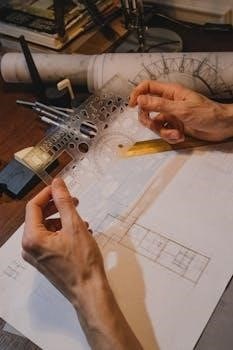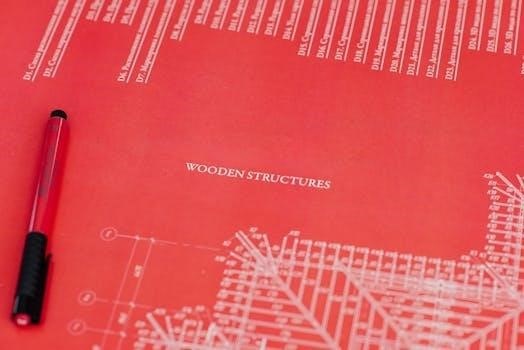AR-15 Schematic PDF⁚ A Comprehensive Guide

This guide provides an overview of AR-15 schematics in PDF format. Learn where to find, download, and use exploded views. These resources are vital for understanding AR-15 components. Access diagrams for maintenance, customization, and troubleshooting. Discover legal considerations and safe handling practices.
AR-15 schematics are essential tools for firearm enthusiasts, gunsmiths, and anyone interested in understanding the inner workings of this popular rifle. These schematics, often found in PDF format, provide detailed visual representations of the AR-15’s components and their relationships to one another. They serve as invaluable resources for maintenance, repair, customization, and even building an AR-15 from scratch.
These documents typically include exploded views, which illustrate how each part fits together in the assembly. An exploded view is a diagram that shows all the separate pieces of the rifle. This helps in the identification of individual parts, such as the barrel, gas tube, handguards, and the bolt carrier group.
AR-15 schematics are not just diagrams; they are comprehensive guides that can enhance your knowledge and skills in firearm maintenance. Whether you’re a seasoned gun owner or a novice, these schematics provide a clear roadmap to understanding the AR-15. They empower you to perform basic repairs, upgrade components, and maintain your rifle safely and effectively.
Understanding Exploded Views
Exploded views are a crucial aspect of AR-15 schematics, offering a detailed breakdown of the rifle’s components. These diagrams display each part of the AR-15 separately, arranged in a way that illustrates their assembly sequence. This visual representation is invaluable for understanding how each piece fits together and interacts with others within the firearm.

An exploded view typically labels each component with a corresponding number or identifier, which is then referenced in a parts list. This allows users to easily identify specific parts and understand their function within the overall assembly. By examining an exploded view, one can gain insights into the complexity of the AR-15, even for those unfamiliar with firearm mechanics.
Exploded views are particularly useful when disassembling or reassembling an AR-15. They provide a visual guide to ensure that each part is correctly placed and oriented. This is especially helpful for tasks such as cleaning, repairing, or upgrading components. They are also beneficial for diagnosing problems. By comparing the actual rifle to the exploded view, you can often pinpoint the source of a malfunction or identify missing parts.
Locating Free AR-15 Exploded View PDFs
Finding free AR-15 exploded view PDFs is surprisingly straightforward, thanks to the wealth of online resources available to firearm enthusiasts. Many manufacturers, retailers, and gunsmithing websites offer these diagrams as a service to their customers. A simple search engine query using terms like “AR-15 exploded view PDF” or “AR-15 schematic free download” will yield numerous results.
Online forums dedicated to firearms are another excellent source. Members often share links to useful PDFs and other resources. Reputable gun parts retailers frequently provide exploded views of the products they sell. Government agencies and military archives may offer schematics as public domain documents, so exploring these sources can prove fruitful.
When downloading PDFs from the internet, it’s crucial to ensure you are using a trustworthy source to avoid malware or inaccurate information. Look for websites with established reputations and positive reviews. Before downloading, verify that the PDF is indeed an exploded view and not simply marketing material. Always scan downloaded files with antivirus software before opening them.
Key Components in an AR-15 Schematic
An AR-15 schematic provides a detailed breakdown of all the firearm’s components. The key components include the upper receiver assembly, which houses the bolt carrier group, barrel, and handguard. Understanding these components is vital. The lower receiver assembly contains the trigger mechanism, buffer tube, and stock.
The bolt carrier group (BCG) is essential for cycling the action. It includes the bolt, bolt carrier, firing pin, and gas rings. The trigger mechanism consists of the trigger, hammer, sear, and associated springs, responsible for firing the rifle. The handguard protects the shooter’s hand and may include mounting points for accessories.
Other crucial components are the gas system, which cycles the action, and the magazine, which holds the ammunition. Schematics also show smaller parts like pins, springs, and detents, all vital to the rifle’s operation. Each part plays a crucial role in the AR-15’s function, making a thorough understanding of the schematic necessary for maintenance and repair.
Upper Receiver Assembly Diagram
The upper receiver assembly diagram is a crucial part of any AR-15 schematic, detailing the components that sit atop the lower receiver. It shows the barrel, gas system, handguard, and bolt carrier group. The diagram highlights how these parts work together to chamber, fire, and eject rounds. The barrel is connected to the upper receiver and is vital for projectile accuracy.
The gas system, including the gas block and tube, directs gas to cycle the action. Handguards come in various lengths and materials, providing protection and mounting options. The bolt carrier group (BCG) is essential for loading and extracting cartridges. The charging handle allows manual cycling of the action.
The upper receiver itself houses these components, providing a stable platform for operation. Diagrams often show the forward assist and ejection port cover, contributing to reliability. Understanding the upper receiver assembly diagram is essential for maintenance, upgrades, and troubleshooting issues related to cycling and accuracy. Properly assembled components ensure smooth operation and reliable performance of the AR-15 platform.
Lower Receiver Assembly Diagram
The lower receiver assembly diagram details the components that comprise the AR-15’s fire control group, buffer system, and magazine well. This diagram is essential for understanding the function of the trigger, hammer, safety selector, and other parts. The trigger mechanism initiates the firing sequence, while the hammer strikes the firing pin. The safety selector prevents accidental discharge.
The magazine catch secures the magazine in place, and the magazine release allows for quick changes. The buffer tube houses the buffer and spring, which absorb recoil. The pistol grip provides a comfortable hold, while the stock allows for shoulder support. The lower receiver itself serves as the foundation for these parts.
A detailed diagram shows the arrangement and interaction of these components. Understanding this assembly is crucial for maintenance, upgrades, and diagnosing issues like failure to fire or improper cycling. Modifying trigger pull involves adjusting components within the lower receiver. Proper assembly ensures reliable function and safe operation of the AR-15 platform.
Bolt Carrier Group Details
The bolt carrier group (BCG) is the heart of the AR-15, responsible for cycling the action, extracting spent cartridges, and chambering new rounds. A detailed schematic reveals the intricate workings of this critical assembly. Key components include the bolt carrier, bolt, firing pin, cam pin, and firing pin retaining pin.
The bolt carrier houses the bolt and provides the mass necessary for reliable cycling. The bolt locks into the barrel extension, securing the cartridge during firing. The firing pin strikes the primer, igniting the propellant. The cam pin rotates the bolt to lock and unlock it from the barrel extension.
Understanding the BCG is vital for maintenance and troubleshooting. Cleaning and lubricating the BCG ensures smooth operation and prevents malfunctions. A schematic helps identify worn or damaged parts requiring replacement. Common issues include broken firing pins, worn extractors, and gas key leaks. Proper inspection and maintenance of the BCG are essential for reliable AR-15 performance. The diagram also aids in understanding the gas system’s interaction with the BCG.

Trigger Mechanism Breakdown
The AR-15 trigger mechanism is a complex assembly that controls the firing sequence. An exploded view diagram is invaluable for understanding its components and function. Key parts include the trigger, hammer, disconnector, sear, and various springs and pins. Each component plays a critical role in the safe and reliable operation of the firearm.
The trigger initiates the firing sequence when pulled; The hammer strikes the firing pin, igniting the cartridge. The disconnector prevents the rifle from firing more than once per trigger pull in semi-automatic mode. The sear engages the hammer, holding it in the cocked position until the trigger is pulled.
Understanding the trigger mechanism is essential for maintenance, troubleshooting, and customization. A schematic helps identify worn or broken parts. Common issues include trigger reset failures, light strikes, and accidental discharges. Upgrading the trigger mechanism can improve trigger pull weight, smoothness, and overall shooting performance. However, any modifications should be performed by a qualified gunsmith to ensure safety and reliability. The diagram is useful for adjusting the trigger pull, ensuring a crisp and consistent feel.
Handguard and Barrel Components
The handguard and barrel assembly are crucial for accuracy and handling of an AR-15. The handguard protects the shooter’s hand from heat and provides a mounting platform for accessories. Schematics detail different handguard types, including free-float, drop-in, and quad-rail designs. Free-float handguards enhance accuracy by preventing barrel contact.
The barrel is the heart of the AR-15, determining bullet velocity and trajectory. Schematics illustrate barrel components like the gas block, gas tube, and muzzle device. The gas block redirects propellant gases to cycle the action. The gas tube transmits gas to the bolt carrier group. Muzzle devices, such as flash hiders and compensators, reduce recoil and muzzle flash.
Understanding these components aids in maintenance, upgrades, and customization. Schematics help identify compatible handguards and barrels. Proper installation of the gas block and muzzle device is essential for reliable operation. Regular cleaning and inspection of the barrel are crucial for maintaining accuracy. The exploded view is useful when choosing the correct barrel length and twist rate for specific ammunition types.
Importance of Parts Identification for Maintenance
Proper maintenance is crucial for the longevity and reliability of any AR-15. Accurate parts identification is the foundation of effective maintenance. AR-15 schematics in PDF format are invaluable tools for this purpose. These schematics provide detailed exploded views of all components. They show how each part fits within the assembly. Identifying parts correctly ensures that you use the right tools and techniques.
Using the wrong tool can damage components. Incorrect techniques can lead to malfunctions. Regular cleaning and lubrication are essential aspects of AR-15 maintenance. Schematics help you disassemble and reassemble the rifle correctly for cleaning. They also show where lubrication is needed to reduce friction and wear.
Parts identification is especially important when replacing worn or damaged components. Schematics allow you to identify the correct replacement parts. They assist in verifying compatibility with your specific AR-15 model. Understanding the function of each part enhances your ability to diagnose issues. This knowledge helps you troubleshoot problems and perform repairs efficiently. With proper maintenance, your AR-15 will perform reliably for years.
Using Schematics for Custom Builds

AR-15 schematics are indispensable for custom builds, acting as blueprints for assembling a personalized firearm. These diagrams offer a comprehensive visual representation of all components; They clearly illustrate how parts interact, ensuring correct assembly. When planning a custom build, schematics help in selecting compatible parts from different manufacturers. Ensuring compatibility prevents malfunctions and performance issues.
Schematics are crucial when upgrading specific components, such as triggers or handguards. They enable builders to understand the existing assembly. This knowledge aids in determining the best replacement parts. Detailed diagrams assist in modifying existing parts or fitting aftermarket accessories. They also provide critical measurements and tolerances necessary for custom modifications.
Furthermore, schematics aid in troubleshooting during the build process. Builders can reference the diagrams to identify missing parts or incorrect installations. They also help in ensuring that all components are correctly aligned. This ultimately leads to a reliable and functional AR-15 build. With the aid of schematics, custom AR-15 builds become more precise. They also become more efficient, and less prone to errors.
Troubleshooting with AR-15 Schematics
AR-15 schematics are invaluable tools for troubleshooting malfunctions and performance issues. They provide detailed visual guides, enabling users to identify the root cause of problems. When an AR-15 malfunctions, schematics help in systematically examining each component. This includes the upper receiver, lower receiver, bolt carrier group, and trigger mechanism.
By comparing the schematic to the actual assembly, users can pinpoint broken, worn, or incorrectly installed parts. For example, a failure to extract might be due to a damaged extractor. The schematic helps in locating and inspecting this part. Similarly, trigger issues can be diagnosed by examining the trigger assembly diagram. It helps in identifying problems with the hammer, sear, or disconnector.
Schematics also aid in understanding how components interact. This understanding is crucial for diagnosing complex issues. They ensure all parts are correctly aligned and functioning within specifications. When ordering replacement parts, schematics provide accurate part numbers and descriptions. This prevents the purchase of incorrect components. With schematics, troubleshooting becomes more efficient. It also becomes more accurate, saving time and money.
Legal Considerations and Safe Handling
Working with AR-15s requires strict adherence to legal regulations and safety protocols; Before disassembling or modifying any firearm, familiarize yourself with federal, state, and local laws. These laws govern ownership, assembly, and modification of AR-15 rifles. Ensure compliance to avoid legal repercussions. Always verify the legality of any modifications or parts you intend to install.
Safe handling practices are paramount when working with firearms. Always treat every AR-15 as if it is loaded, even when disassembling it. Keep the muzzle pointed in a safe direction at all times. Wear appropriate safety gear, including eye and ear protection, to prevent injury. Before disassembling, ensure the firearm is unloaded by visually inspecting the chamber. Remove the magazine and double-check that no ammunition remains.
When using AR-15 schematics, work in a clean, well-lit area to prevent loss of small parts. Follow the disassembly instructions carefully, and never force components. Store your AR-15 and all parts securely, away from unauthorized access. Always prioritize safety and legality when handling and modifying AR-15 rifles.
